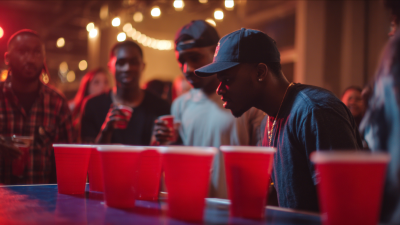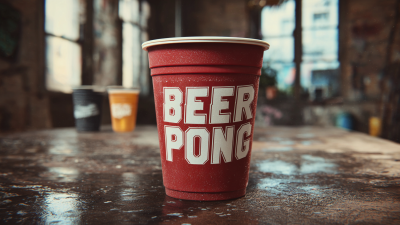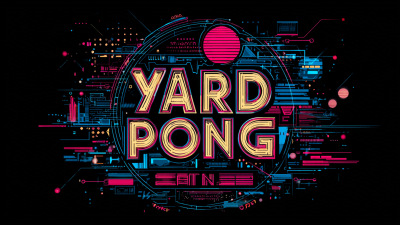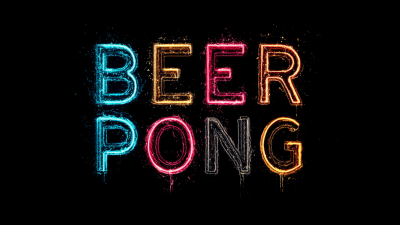Beer Pong, a game that combines skill, strategy, and a touch of friendly competition, has become a staple at social gatherings and college parties across the globe. According to a report by the National Institute on Alcohol Abuse and Alcoholism, approximately 67% of college students engage in some form of drinking games, with Beer Pong standing out as the most popular option. This statistic highlights not only the game's widespread appeal but also its cultural significance within social settings.
As players flick their wrists to send ping pong balls sailing across tables lined with cups of beer, they participate in a pastime that is steeped in both fun and scientific principles. Research from the Journal of Experimental Psychology indicates that the success in Beer Pong is influenced not only by motor skills but also by factors such as spatial awareness and concentration. By delving into these aspects, players can refine their techniques, enhance their gameplay, and bring a more strategic approach to the classic party game. This guide will explore the fascinating science behind Beer Pong, offering tips and tricks to help you master the art of this beloved game while ensuring an entertaining experience for all participants.

Understanding the physics of beer pong is essential for players looking to enhance their gameplay through optimal trajectories and angles. When aiming to land a ping pong ball in a cup, the angle of release and the force applied are critical factors that can greatly affect performance. A study from the Physics Education Research Group indicates that an angle of about 45 degrees typically provides the best chance for achieving maximum distance, suggesting that players should focus on finding that sweet spot when taking their shots.
Moreover, the trajectory of the ball is influenced by factors such as initial velocity and air resistance. Research published in the Journal of Sports Physics has shown that increasing the speed at which the ball is thrown can create a more favorable parabola, allowing the ball to arc gracefully toward its target. Players can experiment with different throwing techniques—such as the classic overhand throw versus a more gentle underhand toss—to find which gives them the most consistent results. Combining an understanding of these physics principles with practice can significantly elevate your beer pong skills, transforming an enjoyable pastime into a competitive edge in any gathering.
As beer pong continues to be a favored pastime among college students, statistics reveal its widespread popularity across campuses. According to a recent survey conducted by the National Institute on Alcohol Abuse and Alcoholism, about 60% of college students reported playing beer pong at least once during their college tenure. This statistic underlines how ingrained the game has become in social gatherings, often acting as a catalyst for bonding among peers. Furthermore, a study from the American Psychological Association indicates that competitive drinking games like beer pong contribute to heightened social interactions, demonstrating how the game fosters a sense of community among students.
To elevate your beer pong skills, consider these simple tips: First, focus on your stance. A balanced and stable position can significantly improve your aim. Second, practice your throw techniques. Whether you prefer a flick of the wrist or a full-arm throw, consistency is key to sinking those cups. Lastly, refining your strategy can enhance your game; observe your opponents and adjust your tactics based on their playing style. Happy ponging!
When it comes to beer pong, cup configuration can significantly impact the outcome of the game. The conventional triangle formation is widely used, but experimenting with different setups can give players a strategic edge. For instance, while a classic formation allows for optimal targeting, staggered arrangements may confuse opponents and make it harder for them to anticipate which cups are left. Understanding the dynamics of your setup is crucial; for example, placing the cups further apart can encourage acrobatic throws, while a tighter formation may lead to more focused shots.
Additionally, the arrangement of cups can influence the psychological aspect of the game. A well-structured layout not only showcases confidence but can also intimidate your opponent. Players often benefit from positioning their cups in a way that highlights their strength, allowing for greater concentration during crucial moments. Therefore, whether you prioritize a balanced triangle or choose a more creative configuration, the way you set up your cups could be the key to developing effective strategies for success in beer pong.
| Cup Configuration | Strategy for Success | Fun Fact | Common Mistake |
|---|---|---|---|
| Triangle Formation | Maximizes coverage and angles for easier shots | The game dates back to the 1950s | Not adjusting angle based on distance to cups |
| Diamond Formation | Less crowded, allowing for better targeting | Beer Pong originated as a college game | Inconsistent throwing technique |
| Straight Line Formation | Easier to hit specific cups | Players often create house rules | Ignoring rebounds and bounces |
| Circle Formation | Unique configuration to confuse opponents | There are national championships for beer pong | Overthinking shot selection |
Improving your aim in beer pong can be enhanced by applying insights from sports science studies. One key strategy is to focus on the biomechanics of throwing, which involves understanding your stance, grip, and the trajectory of the ball. Proper body mechanics can significantly increase your accuracy. For instance, aiming with your dominant eye aligned with your target can help refine your focus and improve your precision.
Additionally, practicing visualization techniques can enhance your performance. Athletes often use mental imagery to rehearse their movements and boost confidence. Before taking your shot, envision the successful arc of the ball as it lands in the cup. This mental preparation can lead to measurable improvements in your aim. Furthermore, incorporating a consistent routine before each throw can establish muscle memory, making your shots more reliable over time. Understanding the science behind these techniques can elevate your beer pong game from casual fun to a competitive edge.
The game of beer pong is not only a test of skill but also an intriguing exploration of how alcohol influences performance. Drinking alcohol can alter a player’s coordination and decision-making abilities, often leading to a paradoxical improvement in performance. Many players report that they seem to shoot better after a few drinks, suggesting that the effects of alcohol might lower inhibitions and enhance confidence. This phenomenon raises interesting questions about how a moderate amount of alcohol might enhance gameplay in social settings.
However, the effects are nuanced. While alcohol can help some players feel more relaxed and intuitive, it can simultaneously impair fine motor skills and judgment. The balance between these opposing effects varies depending on the individual and the amount consumed. As players navigate the fine line between fun and overindulgence in games like beer pong, understanding these dynamics can enhance both enjoyment and performance, making strategy as important as skill. Thus, while a little booze may boost your game, remaining mindful of its limits is key to maintaining the spirit of friendly competition.






